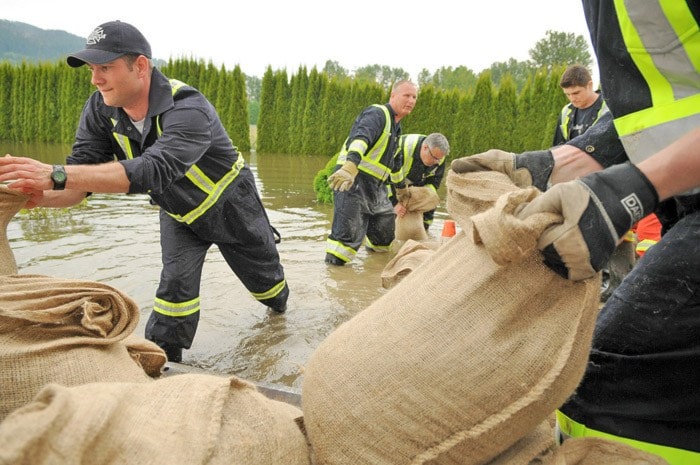“This was not an act of God,” said one resident, but the result of failure to maintain the river bank. “It’s mismanagement, basically,” he said.
Resident John van den Brink said he told city officials three years ago that the bank was eroding, but nothing was done.
Now the city won’t step in to close the breach, he said, and the river has found a new route that will put more properties outside the dike at risk down the shoreline as the river rises with the spring freshet.
“It’s not going to fix itself, and it’s just going to get worse,” he said.
Chilliwack Mayor Sharon Gaetz said the city reacted immediately to the residents’ midnight call for help, and fast action by volunteer firefighters kept the water from entering any of the three homes at risk.
She said the city has been told by flood specialists that armoring a river bank against the force of a direct river current is an “exercise in futility,” and cited the example of the Island 22 campsite that was lost to erosion when the river changed direction.
The mayor couldn’t say why the change in direction occurred at Ballam Road, but residents there speculated that gravel removed from the river last year near Jesperson Road was to blame.
But Chilliwack MLA John Les, an advocate of gravel removal for flood protection, said a hydrologist studies each removal site before it is approved.
“I really don’t think that (gravel removal) altered the course of the river, or would have,” he said, in a telephone interview Wednesday.
Les, the former mayor of Chilliwack, said residents living outside the dike are in a “nebulous” area where government jurisdiction is not “well-defined,” so it’s not clear who is responsible for maintaining river banks.
However, he said when he was mayor in the late ‘90s “I recognized the danger of just allowing this (bank erosion at Ballam Road) to proceed unchecked, so I spent some city money, a bit of an investment to help preclude more serious erosion.”
That investment apparently held until Sunday night when the bank finally collapsed.
Resident Larry Wigham suggested the city could have prevented the flood by acting sooner to shore up the bank when alerted by area residents.
He suggested that residents living outside the dikes are getting short shrift from the city, unlike the days before amalgamation when the Township of Chilliwack delivered services.
outside the dikes are getting short shrift from the city, unlike the days before amalgamation when the Township of Chilliwack delivered services.
“If there was a little problem, they fixed it before it became a big problem,” he said, looking at the river now flowing over his land. “But after amalgamation, nothing gets done.”
“All they want to do is keep building the dike higher and higher, and protecting all those guys over there,” he said.
Les said residents living behind Chilliwack’s dikes should have no fear of flooding this year, but those living outside them may indeed be in trouble if mountain snowpacks that feed the river melt too quickly in a sudden hot spell.
He said the gap created by the collapsed bank at Ballam Road might be controlled using a “weir” system, but even that method may not be possible at this stage of the spring freshet.
The Fraser River at full freshet is “an awesome force to behold,” he said, and can “scour holes as deep as 100 feet.”
Gaetz agreed that Chilliwack residents living behind the dikes should have no fear of a flood, but should always keep an eye on the river.
Provincial officials estimate the Fraser will rise to six metres this year, but Chilliwack dikes are designed to hold back eight metres.
The City starts a program of regular dike inspections when the river level hits 5.5 metres, which ramps up to daily inspections if the level hits 6 metres.
In 2007, the city spent $1.4 million to raise a wing dike from Young Road to the Island 22 boat launch, and used $3.7 million provided by the B.C. government to shore up sections of the east dike, the city’s main flood protection.
Ballam Road residents may be eligible for funding from the Provincial Emergency Program, but officials were not available for comment by deadline Wednesday.
rfreeman@theprogress.com
